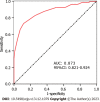Analysis of influencing factors and the construction of predictive models for postpartum depression in older pregnant women
- PMID: 38186720
- PMCID: PMC10768492
- DOI: 10.5498/wjp.v13.i12.1079
Analysis of influencing factors and the construction of predictive models for postpartum depression in older pregnant women
Abstract
Background: Changes in China's fertility policy have led to a significant increase in older pregnant women. At present, there is a lack of analysis of influencing factors and research on predictive models for postpartum depression (PPD) in older pregnant women.
Aim: To analysis the influencing factors and the construction of predictive models for PPD in older pregnant women.
Methods: By adopting a cross-sectional survey research design, 239 older pregnant women (≥ 35 years old) who underwent obstetric examinations and gave birth at Suzhou Ninth People's Hospital from February 2022 to July 2023 were selected as the research subjects. When postpartum women of advanced maternal age came to the hospital for follow-up 42 d after birth, the Edinburgh PPD Scale (EPDS) was used to assess the presence of PPD symptoms. The women were divided into a PPD group and a no-PPD group. Two sets of data were collected for analysis, and a prediction model was constructed. The performance of the predictive model was evaluated using receiver operating characteristic (ROC) analysis and the Hosmer-Lemeshow goodness-of-fit test.
Results: On the 42nd day after delivery, 51 of 239 older pregnant women were evaluated with the EPDS scale and found to have depressive symptoms. The incidence rate was 21.34% (51/239). There were statistically significant differences between the PPD group and the no-PPD group in terms of education level (P = 0.004), family relationships (P = 0.001), pregnancy complications (P = 0.019), and mother-infant separation after birth (P = 0.002). Multivariate logistic regression analysis showed that a high school education and below, poor family relationships, pregnancy complications, and the separation of the mother and baby after birth were influencing factors for PPD in older pregnant women (P < 0.05). Based on the influencing factors, the following model equation was developed: Logit (P) = 0.729 × education level + 0.942 × family relationship + 1.137 × pregnancy complications + 1.285 × separation of the mother and infant after birth -6.671. The area under the ROC curve of this prediction model was 0.873 (95%CI: 0.821-0.924), the sensitivity was 0.871, and the specificity was 0.815. The deviation between the value predicted by the model and the actual value through the Hosmer-Lemeshow goodness-of-fit test was not statistically significant (χ2 = 2.749, P = 0.638), indicating that the model did not show an overfitting phenomenon.
Conclusion: The risk of PPD among older pregnant women is influenced by educational level, family relationships, pregnancy complications, and the separation of the mother and baby after birth. A prediction model based on these factors can effectively predict the risk of PPD in older pregnant women.
Keywords: Influencing factors; Older pregnant women; Postpartum depression; Prediction model.
©The Author(s) 2023. Published by Baishideng Publishing Group Inc. All rights reserved.
Conflict of interest statement
Conflict-of-interest statement: We have no financial relationships to disclose.
Figures
Similar articles
-
Relationship between gestational body mass index, blood pressure variability, and postpartum depression in pregnant women with pre-eclampsia.World J Psychiatry. 2024 Dec 19;14(12):1868-1875. doi: 10.5498/wjp.v14.i12.1868. eCollection 2024 Dec 19. World J Psychiatry. 2024. PMID: 39704358 Free PMC article.
-
Construction and validation of a personalized prediction model for postpartum anxiety in pregnant women with preeclampsia.World J Psychiatry. 2023 Oct 19;13(10):763-771. doi: 10.5498/wjp.v13.i10.763. eCollection 2023 Oct 19. World J Psychiatry. 2023. PMID: 38058687 Free PMC article.
-
Establishment and Validation of Risk Prediction Model for Postpartum Hemorrhage for Pregnant Women ≥35 Years of Age in Natural Delivery.Altern Ther Health Med. 2023 Nov;29(8):876-881. Altern Ther Health Med. 2023. PMID: 37708560
-
Association between Vitamin D Levels During Pregnancy and Postpartum Depression: A Narrative Reviews.Iran J Nurs Midwifery Res. 2024 Jul 2;29(3):290-296. doi: 10.4103/ijnmr.ijnmr_49_23. eCollection 2024 May-Jun. Iran J Nurs Midwifery Res. 2024. PMID: 39100406 Free PMC article. Review.
-
Predictive Validity of Screening Tools and Role of Self-Esteem and Coping in Postpartum Depression Risk.Diagnostics (Basel). 2025 Apr 30;15(9):1152. doi: 10.3390/diagnostics15091152. Diagnostics (Basel). 2025. PMID: 40361970 Free PMC article. Review.
Cited by
-
Comparing the prevalence and influencing factors of postpartum depression in primiparous and multiparous women in China.Front Psychiatry. 2024 Oct 4;15:1479427. doi: 10.3389/fpsyt.2024.1479427. eCollection 2024. Front Psychiatry. 2024. PMID: 39429531 Free PMC article.
-
Prevalence and factors influencing postpartum depression and its culture-specific cutoffs for women in Asia: a scoping review.Ewha Med J. 2025 Jan;48(1):e15. doi: 10.12771/emj.2025.e15. Epub 2025 Jan 31. Ewha Med J. 2025. PMID: 40704201 Free PMC article. Review.
-
Relationship between gestational body mass index, blood pressure variability, and postpartum depression in pregnant women with pre-eclampsia.World J Psychiatry. 2024 Dec 19;14(12):1868-1875. doi: 10.5498/wjp.v14.i12.1868. eCollection 2024 Dec 19. World J Psychiatry. 2024. PMID: 39704358 Free PMC article.
-
Research fronts and researchers of World Journal of Psychiatry in 2023: A visualization and analysis of mapping knowledge domains.World J Psychiatry. 2024 Jul 19;14(7):1118-1126. doi: 10.5498/wjp.v14.i7.1118. eCollection 2024 Jul 19. World J Psychiatry. 2024. PMID: 39050206 Free PMC article.
-
A method for predicting postpartum depression via an ensemble neural network model.Front Public Health. 2025 Apr 14;13:1571522. doi: 10.3389/fpubh.2025.1571522. eCollection 2025. Front Public Health. 2025. PMID: 40297040 Free PMC article.
References
-
- Lu L, Dongyan J. Research progress on postpartum depression and nursing intervention measures in elderly postpartum women. Nursing Research. 2019;33:269–272.
-
- Zhao XH, Zhang ZH. Risk factors for postpartum depression: An evidence-based systematic review of systematic reviews and meta-analyses. Asian J Psychiatr. 2020;53:102353. - PubMed
LinkOut - more resources
Full Text Sources


